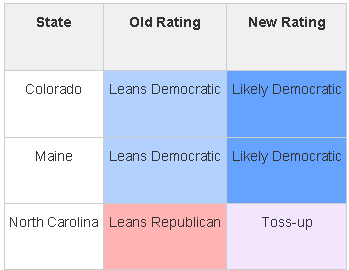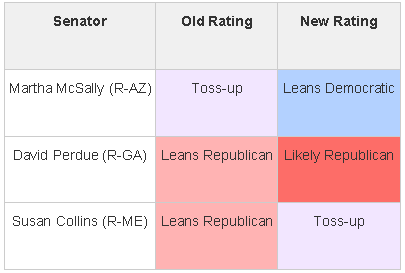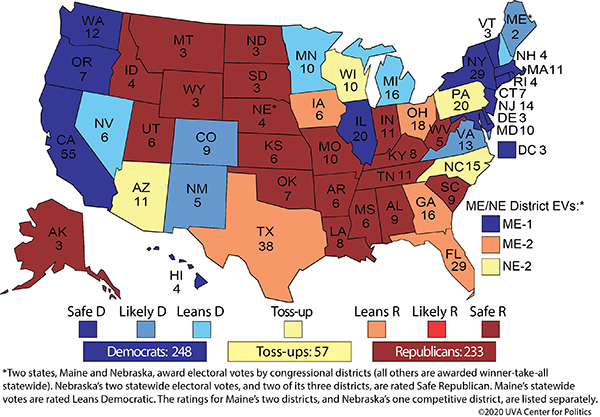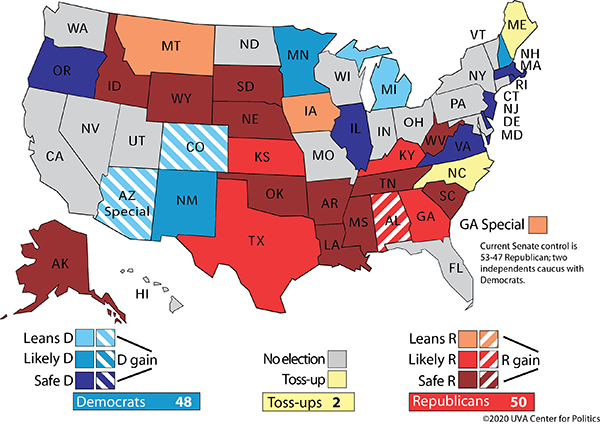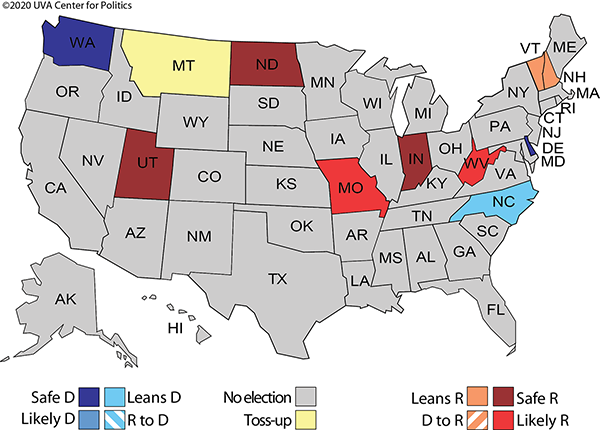Rating Changes: Electoral College and Senate
A Commentary By Kyle Kondik
Democrats edge slightly ahead, but presidential race still a Toss-up; upper chamber battle gets closer; governors face what likely will be the biggest test of their tenures
KEY POINTS FROM THIS ARTICLE
-- We are not dramatically revising our outlook for the presidential election, at least not yet.
-- That said, several rating changes in the Electoral College and Senate generally benefit Democrats.
-- Many governors are getting high marks for their responses to the crisis; even for those elected in 2018, the most consequential and high-profile test of their tenures is probably happening right now.
Table 1: Crystal Ball Electoral College rating changes
Table 2: Crystal Ball Senate rating changes
The Electoral College
While the public health crisis has complicated the president’s path to a second term, we think it’s premature to make dramatic changes to our assessment of the presidential election. We’ve long thought the president’s chances of reelection have been around 50-50. In light of recent developments, it may be that the president’s odds are a little bit lower now, but we don’t think the data suggest going further than that at this time.
This slight change in our overall assessment is reflected in the new ratings, which are shown in Map 1. We are moving North Carolina from Leans Republican to Toss-up, and also moving Colorado and Maine’s two statewide electoral votes from Leans Democratic to Likely Democratic.
Map 1: Crystal Ball Electoral College ratings
Joe Biden has consistently led Donald Trump in North Carolina polling, albeit only by a few points. Trump won it by about 3.5 points in 2016, about the same as Arizona, another historically Republican presidential state we rate as a Toss-up.
Trump’s win in the Tar Heel State, particularly the margin, was somewhat surprising: Many plugged-in observers were very pessimistic about Trump’s odds in North Carolina in 2016, owing to their belief that Trump would underperform typical GOP performance in the state’s population centers, namely Charlotte and Raleigh. That did in fact happen, although not as sharply as some expected, but Trump more than compensated for that by improving on usual Republican performance outside of those urban centers, most notably in more sparsely-populated western and southern North Carolina. We think the Democrats have room to keep growing in the big metro areas, and perhaps also in the African-American vote if Democrats can generate better turnout from this group of voters. Then again, Trump may have room to grow in outstate areas as well. Overall, the state is competitive enough that we think Toss-up is the better rating.
Meanwhile, Colorado’s trajectory has been similar to that of Virginia's: Both states have been becoming more Democratic thanks in large part to the continued shift of many white voters with four-year college degrees into the Democratic column (both states have higher-than-average formal education levels). One of the consequences of Trump’s behavior in office is that while he has held the GOP coalition together, he hasn’t really expanded his appeal all that much among voters who were skeptical of him in 2016. Trump lost both Colorado and Virginia by five points in 2016. That’s a big gap to make up: too big, we think, given the present circumstances.
Maine was closer in 2016 -- a three-point margin -- and while Trump is probably still on track to win the single electoral vote in Maine’s Second Congressional District, we don’t see him making up much if any ground in the First District, which casts more votes than the Second District and is more liberal. That should be enough to give the Democratic nominee three of the four electoral votes in Maine. The only other state that splits its electoral votes this way is Nebraska, where the Second District is also a Toss-up while the rest of the state is Safe Republican. We looked at both states in depth earlier this year.
This puts our Electoral College tally as 248 for the Democrats, 233 for the Republicans, and 57 electoral votes in the Toss-up category (Arizona, North Carolina, Pennsylvania, Wisconsin, and the aforementioned single electoral vote in the Omaha-based NE-2).
While the Democrats are nominally ahead now, these ratings reflect a presidential race that we would still characterize as a Toss-up overall. Based on our ratings, both sides are still multiple states away from an Electoral College majority.
The Senate
The battle for the Senate is getting more competitive, with Democrats pushing the overall map more into Toss-up territory. Two of our rating changes reflect that overall picture this week.
Map 2: Crystal Ball Senate ratings
First of all, we’re moving the special election in Arizona from Toss-up to Leans Democratic this week. Likely Democratic nominee Mark Kelly (D), a former astronaut who is the husband of former Rep. Gabrielle Giffords (D-AZ), has consistently led appointed Sen. Martha McSally (R-AZ) in polling, and not just by a little: four surveys in March showed Kelly up anywhere from five to 12 points, a better margin than Biden enjoys in the state (he has led Trump there in polling, but by smaller margins).
We came away from 2018 a bit skeptical of McSally as a candidate: She lost to now-Sen. Kyrsten Sinema (D-AZ) by about 2.5 points, and McSally was not quite able to translate her impressive background as an accomplished Air Force pilot into an appealing persona as a candidate. She has spent much of her time as a Senate appointee trying to consolidate support on the right, a task she apparently has not yet accomplished given that Trump appears to be doing better in the state than she is. Kelly also has a considerable fundraising advantage on McSally.
Surely some Republicans will think we’re being too bullish on Democratic Senate odds in Arizona, just like some believe we’re too bullish on Democrats in Colorado, another GOP Senate state we rate as Leans Democratic. But we would just rather be the Democrats in both states at this point in time; that of course can change.
We are also moving Sen. Susan Collins (R-ME) from Leans Republican to Toss-up. We’ve resisted this change for a while, but it’s become apparent to us that Collins is in for a very close race, even if she may retain a lead at this precise moment. Her likeliest opponent is state House Speaker Sara Gideon (D).
There is one positive rating change for Republicans. We have not been very impressed by Democratic recruitment for both Senate races in Georgia, and we’re upgrading Sen. David Perdue (R-GA) from Leans Republican to Likely Republican. We’re also tempted to move the Senate special election there to Likely Republican, but we’re going to hold off in light of the potential for appointed Sen. Kelly Loeffler (R-GA) to be damaged by recent reporting that she benefited from a stock sell-off before the markets took a dive as the coronavirus pandemic emerged, prompting accusations of a form of insider trading. She has denied any wrongdoing and argued that she has outsourced her investment decisions to an investment firm. It’s possible that if the story has an impact, it could help Rep. Doug Collins (R, GA-9), Loeffler's GOP rival, as much or more than the Democrats; all candidates are running together in a special election this November, with a January 2021 runoff looming in the likely event no one gets over 50% in the special.
These rating changes help clarify tiers of targets for Democrats in November. Assuming that Republicans defeat Sen. Doug Jones (D-AL), which we see as likely, Democrats need to win at least four currently Republican seats to get to a 50-50 tie in the Senate, which the incoming vice president would break.
We have Democrats favored in two Republican seats, Arizona and Colorado. Then there are two genuine Toss-ups, Maine and North Carolina, followed by Leans Republican states Iowa and Montana, along with the Georgia Senate special. These states are where the Senate majority will be won, in all likelihood.
This generally reflects some of the early ad bookings from two of the major outside Senate campaign groups, Senate Leadership Fund (pro-Republican) and Senate Majority PAC (pro-Democratic). Both booked close to $70 million in ad spending in five of the six same states: Arizona, Colorado, Iowa, Maine, and North Carolina. The one outlier was that SLF, the pro-GOP group, also booked time in Kentucky, where Senate Majority Leader Mitch McConnell (R-KY) is seeking a seventh term. We rate Kentucky as Likely Republican. These bookings are always interesting because they telegraph the races that party operatives are prioritizing the most. But they also are subject to cancellation -- or enhancement.
We’ll have more to say specifically on the House next week, but Democrats continue to be favored to hold their House majority. One of the many aftereffects of the coronavirus crisis may be that it could give Democrats in Trump-won districts an opportunity to emphasize their own responses to the disaster after Republicans were hoping to use impeachment as a way to tie these Democrats to national Democratic leaders.
We were skeptical even during impeachment that it would be a major focus of the fall campaign; coronavirus is likely pushing that battle even further out of the public consciousness. That’s probably a net-positive for the most vulnerable House Democrats.
Governors generally getting high marks
While the ultimate effects of the pandemic on the presidential race may be somewhat nebulous, from a polling standpoint, perhaps the biggest beneficiaries out of this episode will be the nation’s governors. Last week, national polling from Monmouth University showed that 72% approved of how their state’s chief executives were handling the outbreak, compared to 50% for the president. Wednesday morning, Politico/Morning Consult found that 43% of voters said that Trump was doing an "excellent" or "good" job handling coronavirus, but 62% gave those high marks to their governor. On Wednesday afternoon, Wisconsin's respected Marquette Law School poll showed a similar gap between Gov. Tony Evers (D-WI) and Trump in the electorally vital state, with 76% of respondents saying they strongly or somewhat approve of how Evers has dealt with coronavirus, with 51% saying the same of Trump.
Although the news cycle is increasingly driven by the events in Washington D.C., governors are often the foremost elected officials in their states. Perhaps two of the most visible governors during this crisis have been Govs. Mike DeWine (R-OH) and Andrew Cuomo (D-NY) -- both now sport roughly 70% approval/favorable ratings, according to recent state-level polling. Cuomo's favorability is up roughly 25 points from where it was earlier this year in polling from Siena College, which has regularly polled the governor throughout his nearly decade-long governorship.
Still, some examples from recent decades illustrate pitfalls for governors. Politically, this pandemic could play out much like a natural disaster. In 2005, during the aftermath of Hurricane Katrina, Gov. Kathleen Blanco (D-LA), fairly or unfairly, was blamed for the state’s slow response. This ultimately made her a nonstarter for reelection in 2007, and she retired after one term. Much like how Trump quarreled with Gov. Gretchen Whitmer (D-MI), referring to her as that “woman in Michigan,” Louisiana Democrats accused the George W. Bush White House of undermining Blanco.
In 2016, Gov. Pat McCrory (R-NC) was in a competitive reelection race but trailed in most polls. A month before the election, Hurricane Matthew blew through North Carolina. Even after he received roundly positive press for his handling of the storm, he was defeated, although by just two-tenths of a percentage point.
In 2014, an Ebola outbreak in Africa became a topic in the closing weeks of the campaign season. Though it figured most prominently into Senate campaigns that year, it became a gubernatorial issue in the state geographically closest to Africa: Maine. Then-Gov. Paul LePage (R-ME) made headlines with his handling of the threat, as he insisted on quarantining a nurse who had just returned from treating patients in West Africa. Despite criticism that his antics were heavy-handed, he was reelected by a surprisingly comfortable 48%-43% margin; it's hard to argue that the late-breaking controversy hurt him.
In 2011, then-Gov. Jay Nixon (D-MO) was widely credited for a good response to a deadly tornado in southwest Missouri, and it may have helped his 2012 reelection, at least in the places most affected by the disaster.
The lion’s share of the nation’s governors are up for reelection in 2022 -- our ratings for the scattered races on the ballot this year are shown in Map 3.
Even though many of the most notable governors who have emerged in this crisis are less than mid-way through their terms, it stands to reason that the most trying and memorable event of their governorships is happening right now. That could be a reelection asset for governors running for new terms in 2022, assuming voters look back on their responses favorably.
Map 3: Crystal Ball gubernatorial ratings
Kyle Kondik is a Political Analyst at the Center for Politics at the University of Virginia and the Managing Editor of Sabato's Crystal Ball.
See Other Political Commentary by Kyle Kondik.
See Other Political Commentary.
This article is reprinted from Sabato's Crystal Ball.
Views expressed in this column are those of the author, not those of Rasmussen Reports. Comments about this content should be directed to the author or syndicate.
Rasmussen Reports is a media company specializing in the collection, publication and distribution of public opinion information.
We conduct public opinion polls on a variety of topics to inform our audience on events in the news and other topics of interest. To ensure editorial control and independence, we pay for the polls ourselves and generate revenue through the sale of subscriptions, sponsorships, and advertising. Nightly polling on politics, business and lifestyle topics provides the content to update the Rasmussen Reports web site many times each day. If it's in the news, it's in our polls. Additionally, the data drives a daily update newsletter and various media outlets across the country.
Some information, including the Rasmussen Reports daily Presidential Tracking Poll and commentaries are available for free to the general public. Subscriptions are available for $4.95 a month or 34.95 a year that provide subscribers with exclusive access to more than 20 stories per week on upcoming elections, consumer confidence, and issues that affect us all. For those who are really into the numbers, Platinum Members can review demographic crosstabs and a full history of our data.
To learn more about our methodology, click here.
